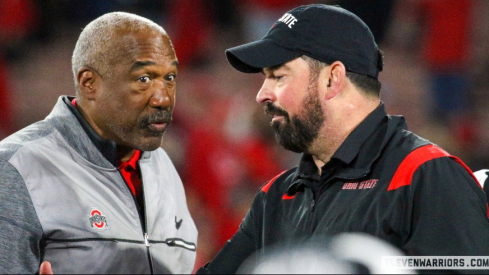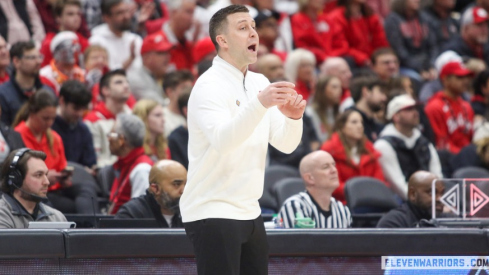
Ohio State had little difficulty moving the football against Northwestern but turnovers and red zone inefficiency put Ohio State in a precarious position.
The Wildcats made the strategic decision to try and take away the Buckeyes' run and deep passing game. Northwestern sought to bend against Ohio State's offense until the Buckeyes reached the red zone. There, the Wildcats shifted to cover 0 to prevent the Buckeyes from running the football. This strategy was effective in the first half in keeping Ohio State out of the end zone.
The Wildcats had difficulty stopping Ohio State offense in the second half, however, as Ohio State largely ran at will behind Carlos Hyde and the Ohio State offensive line. Nor could the Wildcats get third down stops once Miller and the Buckeyes discovered that Northwestern's zone coverage was leaving Hyde open underneath. And Miller overcame early turnovers to again demonstrate an ability to make plays when Ohio State needed him most.
Below I examine Northwestern's defensive strategy, what led to Ohio State's first half problems, the Buckeyes' second half adjustments and Miller and Hyde's performances.
Doing the Limbo
Knowing they could not shut down Ohio State's offense, Northwestern instead focused on limiting where the Buckeyes are most efficient. Specifically, the Wildcats wanted to a) apply numbers against the Buckeye run game and contain Miller and b) prevent Ohio State from hitting pass plays over the top.
To do so the Wildcats utilized their 4-3 over defense. Northwestern sought to apply one more defender in the box then Ohio State had blockers, often having their defenders split the difference between the Buckeyes' tackle and slot receiver when Ohio State went four wide. When the Buckeyes aligned tight end Jeff Heuerman on the line of scrimmage the Wildcats generally put seven defenders in the box.

In the secondary the Wildcats often played cover 3, frequently using a 3 man rush to play three deep and five underneath defenders. The deep defenders' primary goal was preventing Ohio State from getting behind them with the pass.

Northwestern did an about face in the red zone, playing cover 0 with no middle of the field safety help.

Spinning the Wheels
The Wildcat defense had middling success but initially accomplished its ultimate goal. The Buckeyes came out successfully throwing the football using play action often from trips alignments. Throughout the game Northwestern could not stop Ohio State throwing play action hitch or deep crossing routes. With the latter Brown works inside as if he is running a curl and then get depth at 17-22 yards. He will run to the area that is vacated by two deep posts from the opposite side of the field.

The hitch was a packaged play, meaning that Miller had a run/pass option post-snap. The Ohio State offensive line ran power from the pistol. Miller read the front side outside linebacker. If he played the run he would pull and throw the hitch. Ohio State has increasingly utilized packaged plays this season as the coaching staff grows more comfortable with Miller's ability to operate the read.

Ohio State also often brought a TE or WR in motion across the formation to successfully block back against the extra Wildcat defender in the box.
The Buckeyes bogged down in the red zone against Northwestern's cover 0, however. The Buckeyes sought to run lead plays with Braxton Miller to re-equate numbers, but the Buckeyes still did not have adequate blockers.

When Ohio State did throw the football, Miller missed an open Chris Fields. The result was that a Buckeye offense that has been very efficient in the red zone under Urban Meyer had to kick two first half red zone field goals.
Northwestern also prevented Ohio State from hitting a deep post or vertical route. The Buckeyes had several chances but could not convert. In so doing the Buckeyes' offense ran headfirst into Northwestern's deep safeties and drifted away from what was effective, namely running Hyde and play-action passing.
Cleaning it up
The biggest issues into the early third quarter, however, was the most most obvious – turnovers – specifically Miller's fumbles. Losing the turnover battle is one of the biggest predictors of losing the game, and it took all the Buckeyes' efforts (and a blocked punt) to overcome three giveaways.
Once the Buckeyes stopped turning the football over they were difficult to stop. This has several components with the dominance of Hyde and the offensive line being the most obvious. The Buckeyes repeatedly ran inside zone, most often on the left side behind Jack Mewhort and Andrew Norwell. The Buckeyes had success running zone slice blocking (a play Meyer adopted from his NFL film study last winter), with Heuerman blocking back to seal the cutback lane. The Buckeyes controlled the point of attack and Hyde took it from there, generally making the correct read and gaining yards after contact.

Hyde likely played his best game as a Buckeye, particularly in the vision he displayed picking holes. The Buckeyes began beating Northwestern's cover 0 look at the goal line with Hyde drawing Northwestern's defenders inside and then bouncing the run.
To assist that effort Miller had one of his better games executing Ohio State's read plays. Northwestern often used various forms of scrape exchange on both sides to help defend inside zone read and inverted veer. The defensive end would crash down and either an outside linebacker would scrape around or a defensive back would come up to play contain. The goal is to confuse a quarterback with his reads and put a more athletic defender in space.

Miller was not perfect but more often than not he made the correct decision. This was true even on his first fumble, where the defensive end crashed down. If Miller got outside he was set for a big play but the defensive end made a nice play on the football.
Miller's reads were particularly helpful on inverted veer. As noted, Northwestern was running a scrape exchange on the front side, focused on having the crashing end take away Miller. Miller's tendency on that play has generally been to to keep. But against Northwestern Miller correctly gave on the play to Hyde throughout the game. Heuerman was able to cut the scraping linebacker and Hyde had several runs for big gains.

Checkin' Down
As noted, the Buckeyes' passing game was inconsistent early as they tried to force the football down field. Ohio State became far more efficient throwing the football once Miller and the Buckeyes concluded that Northwestern deep zone drops were leaving Hyde uncovered in the flat. Below you can see how Northwestern distributes its cover 3 defense deep against the Buckeyes' snag combination, leaving Hyde uncovered.

The Buckeyes converted several crucial second half first down taking advantage of this vulnerability in the Wildcats' zone. The Buckeyes also returned to the play action hitch and deep cross routes with success.
Making Plays When it Counts
No deep crossing route to Brown was more important then Miller's 38 yard pass on second and one, when he patiently waited for Brown to get across the field after scrambling.

Miller's early turnovers and missed throw to Fields undoubtedly hurt Ohio State's efforts. But he recovered when Ohio State needed him. Though he never played poorly, Miller undoubtedly played his best in the fourth quarter. He ran north and south and made the correct reads in both the run and pass game. This was reminiscent of last season. Miller has repeatedly demonstrated he is at his best and most in the flow of the game when the game is on the line.
Getting Off Script
The Northwestern game again demonstrated Miller and Hyde's missed time has perhaps delayed the Buckeye offensive coaching staff from fully getting in a rhythm as play callers. Meyer and Tom Herman tend to fall back upon two crutches – designed run plays for Miller and drop back deep passing routes. Defenses are still focused upon containing Miller, however, limiting his ability to get outside contain. But in the second half Ohio State demonstrated that they can rely upon their talented offensive line and Hyde as they did last season. In fact, Hyde demonstrated more versatility in posing a threat on inverted veer, providing the Buckeyes another edge runner. Once defenses must concern themselves with Hyde then the Buckeyes can spring Miller outside.
In terms of the passing game, Miller was far more efficient Saturday from play action. This should be expected, as a defense cannot focus on the run and defend the pass. The Buckeyes should continue to emphasize play-action to move Miller and attack behind run-focused second level defenders.
Northwestern had a nice game plan against Ohio State but more often then not it was the Buckeyes stopped themselves. The Buckeyes averaged 6.09 yards per play but only scored .36 points over those plays, owing to turnovers and red zone inefficiency. On a positive front, the Buckeyes' second half adjustments evidenced that Ohio State has multiple ways to attack a defense. The Ohio State offense is explosive but has hit rough patches in each game, largely owing to the Buckeyes' self-imposed mistakes. This is at times a result of Miller having stretches of inconsistency, but is exacerbated by dropped passes on third down and other mistakes. But it also reflects the high ceiling for the Ohio State offense. The Buckeyes can now use a bye week to clean up mistakes and strive for a cleaner performance.

